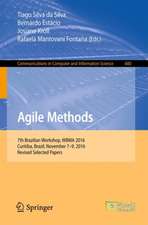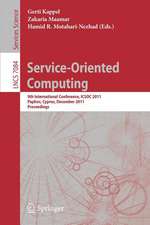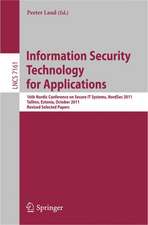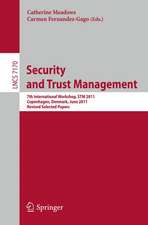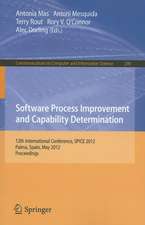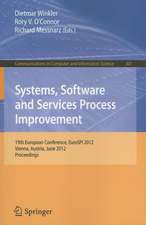The Journey to Enterprise Agility: Systems Thinking and Organizational Legacy
Autor Daryl Kulak, Hong Lien Limba Engleză Hardback – 12 apr 2017
When an enterprise experiments with practice improvements, software development teams often jump on board with excitement, while other groups are left to wonder how they will fit in.
We address how these groups can adapt to Agile teams. More importantly, we show how many Agile teams cause their own problems, damaging scalability and sustainability, by requiring special treatment, and by failing to bridge the gaps between themselves and other groups. We call this phenomenon “Agile illth.”
Adopting a set of “best practices” is not enough. All of us, Agile teams and the corporate groups, must change our intentions and worldviews to be more compatible with the success of the enterprise.
Join us on the journey to enterpriseagility. It is a crooked path, fraught with danger, confusion and complexity. It is the only way to reach the pinnacles we hope to experience in the form of better business value delivered faster for less cost.
| Toate formatele și edițiile | Preț | Express |
|---|---|---|
| Paperback (1) | 455.30 lei 6-8 săpt. | |
| Springer International Publishing – 25 iul 2018 | 455.30 lei 6-8 săpt. | |
| Hardback (1) | 534.36 lei 6-8 săpt. | |
| Springer International Publishing – 12 apr 2017 | 534.36 lei 6-8 săpt. |
Preț: 534.36 lei
Preț vechi: 628.66 lei
-15% Nou
Puncte Express: 802
Preț estimativ în valută:
102.25€ • 107.04$ • 84.60£
102.25€ • 107.04$ • 84.60£
Carte tipărită la comandă
Livrare economică 05-19 aprilie
Preluare comenzi: 021 569.72.76
Specificații
ISBN-13: 9783319540863
ISBN-10: 3319540866
Pagini: 321
Ilustrații: XIX, 286 p. 35 illus., 32 illus. in color.
Dimensiuni: 155 x 235 x 22 mm
Greutate: 0.61 kg
Ediția:1st ed. 2017
Editura: Springer International Publishing
Colecția Springer
Locul publicării:Cham, Switzerland
ISBN-10: 3319540866
Pagini: 321
Ilustrații: XIX, 286 p. 35 illus., 32 illus. in color.
Dimensiuni: 155 x 235 x 22 mm
Greutate: 0.61 kg
Ediția:1st ed. 2017
Editura: Springer International Publishing
Colecția Springer
Locul publicării:Cham, Switzerland
Cuprins
Today’s Problems with Enterprise Business Software.- The Scholars of Systems Thinking.- Worldview and Intentions.- Seven Principles of Systems Thinking for Software Development.- Redefining Professionalism.- Scaling and Sustaining – Avoiding Mechanical Behavior.- Business Value, Estimation and Metrics.- Missing Deadlines Means Missing Market Opportunities.- Flipping the Run/Build Ratio – The Business Case for Software Craftsmanship.- Better Vendor RFPs and Contracts.- Servant Leadership.- How Teams Keep Learning and Improving.- Getting Coaching that Really Helps.- Capitalizing Software Investments.- Integrating Enterprise Methodology and Architecture with Fast-Moving Development Teams.- HR Agility.- Buy versus Build.- Brief Notes on Using Offshore Teams.- Highlighting the Differences Between Software Product Companies and Internal IT.- Conclusion.
Notă biografică
Daryl Kulak is an executive consultant with Pillar Technology in Columbus, Ohio. He has played almost every role on the software development team, from programmer to business analyst to architect to methodologist to tester to manager. Daryl has helped dozens of organizations in making the transition to Agile, and worked on his first iterative and incremental project in 1998 (before the Agile term was coined).
Dr. Hong Li is a senior consultant working in Columbus, Ohio. He was born in China and was one of the lucky ones to survive the Cultural Revolution. He attended Purdue University and University of Pittsburgh, attaining a PhD in Engineering and an MBA. Hong helps organizations with custom software development and data analytical solutions, using an Agile development lifecycle. Hong has done extensive research in the systems thinking field, particularly focusing on Robert Rosen's work with the M-R model and anticipatory systems.
Dr. Hong Li is a senior consultant working in Columbus, Ohio. He was born in China and was one of the lucky ones to survive the Cultural Revolution. He attended Purdue University and University of Pittsburgh, attaining a PhD in Engineering and an MBA. Hong helps organizations with custom software development and data analytical solutions, using an Agile development lifecycle. Hong has done extensive research in the systems thinking field, particularly focusing on Robert Rosen's work with the M-R model and anticipatory systems.
Textul de pe ultima copertă
This is the first book to seriously address the disconnection between nimble Agile teams and other groups in the enterprise, including enterprise architecture, the program management office (PMO), human resources, and even business executives.
When an enterprise experiments with practice improvements, software development teams often jump on board with excitement, while other groups are left to wonder how they will fit in.
We address how these groups can adapt to Agile teams. More importantly, we show how many Agile teams cause their own problems, damaging scalability and sustainability, by requiring special treatment, and by failing to bridge the gaps between themselves and other groups. We call this phenomenon “Agile illth.”
Adopting a set of “best practices” is not enough. All of us, Agile teams and the corporate groups, must change our intentions and worldviews to be more compatible with the success of the enterprise.
Join us on the journey to enterpriseagility. It is a crooked path, fraught with danger, confusion and complexity. It is the only way to reach the pinnacles we hope to experience in the form of better business value delivered faster for less cost.
When an enterprise experiments with practice improvements, software development teams often jump on board with excitement, while other groups are left to wonder how they will fit in.
We address how these groups can adapt to Agile teams. More importantly, we show how many Agile teams cause their own problems, damaging scalability and sustainability, by requiring special treatment, and by failing to bridge the gaps between themselves and other groups. We call this phenomenon “Agile illth.”
Adopting a set of “best practices” is not enough. All of us, Agile teams and the corporate groups, must change our intentions and worldviews to be more compatible with the success of the enterprise.
Join us on the journey to enterpriseagility. It is a crooked path, fraught with danger, confusion and complexity. It is the only way to reach the pinnacles we hope to experience in the form of better business value delivered faster for less cost.
Caracteristici
The first book to provide guidance on addressing the potential mismatch between Agile software teams, program managers, enterprise architects, executives and many other groups A new perspective beyond just the latest “best practices” and into the worldview and intentions that can help software teams succeed Every chapter includes sections on “Test Drive Your Knowledge” and “Try This Next” to reinforce individual learning (for executives, managers and individual contributors) An additional website http://enterpriseagile.biz/ offers a wealth of additional summaries, tips and pitfalls Includes supplementary material: sn.pub/extras











